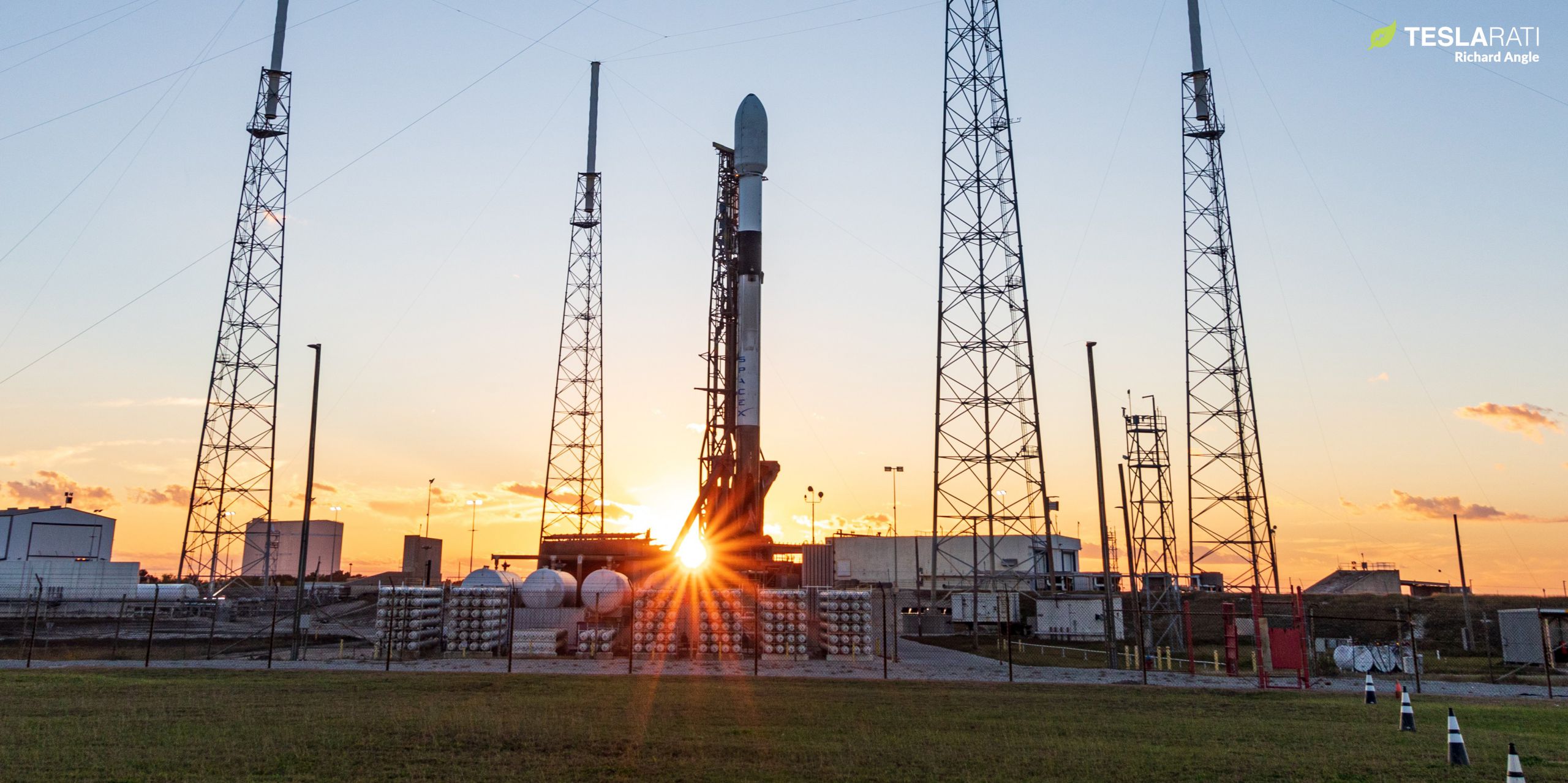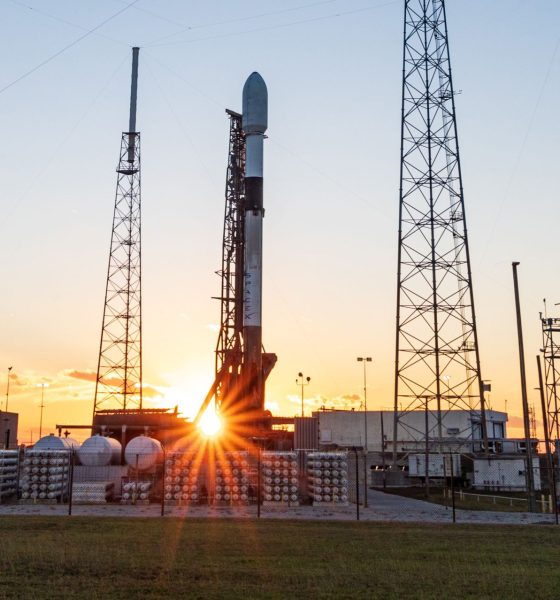

News
SpaceX’s second Starlink Gen2 launch could set payload record [webcast]
SpaceX’s second Starlink Gen2 launch will carry 56 satellites, potentially making it the heaviest payload the company has ever launched.
At 9:30 am EST, SpaceX completed a static fire of the two-stage Falcon 9 rocket assigned to launch its next Starlink mission. Half an hour later, SpaceX confirmed that the rocket performed well and is scheduled to launch no earlier than 4:32 am EST (09:32 UTC) on Thursday, January 26th. SpaceX didn’t state the mission’s purpose, but shorthand (“sl5-2”) used in an official website URL implies that it will be the second launch for its Starlink Gen2 satellite constellation.
SpaceX also reported that Starlink 5-2 will carry 56 satellites, meaning that the mission could set a new Falcon 9 payload record.
The update that's rolling out to the fleet makes full use of the front and rear steering travel to minimize turning circle. In this case a reduction of 1.6 feet just over the air— Wes (@wmorrill3) April 16, 2024
56 is not a record number of satellites for a SpaceX launch or a Starlink launch. SpaceX has launched a record 143 rideshare payloads at once, and the company routinely launched 60 Starlink satellites at a time throughout 2019, 2020, and part of 2021. But those Starlink satellites were the first versions (V1.0) of the spacecraft and weighed either 227 or 260 kilograms (500/570 lbs) apiece.
In the second half of 2021, SpaceX began launching new Starlink V1.5 satellites. Outfitted with new laser links (optical terminals) and other general upgrades, the new satellites reportedly weigh 303, 307, or 309 kilograms (668, 676, or 681 lb) each. The heavier design forced SpaceX to slightly reduce the number of satellites each launch could carry. After some optimization, SpaceX regularly launches up to 54 Starlink V1.5 satellites at a time, down from 60 V1.0 satellites.
The number of satellites may be smaller, but the mass of the payload launched has never been higher. SpaceX last broke Falcon 9’s payload mass record in August 2022, when it launched 54 Starlink V1.5 satellites for the first time. The payload reportedly weighed 16.7 tons (~36,800 lb), breaking the previous record of 16.25 tons by about 3%. The heaviest 60-satellite Starlink V1.0 payload weighed around 15.6 tons (~34,400 lb).

Now, SpaceX says it will launch 56 Starlink satellites – likely heavier V1.5 variants – at once. If SpaceX hasn’t reduced the weight of each satellite, the payload could weigh anywhere from 16.97 to 17.3 tons (37,400-38,200 lb). Starlink 5-2 is targeting the same orbit as Starlink 5-1, which carried 54 satellites. The likeliest explanation for the heavier payload appears to be another iterative improvement to Falcon 9.
As SpaceX gains confidence in and experience with Falcon 9, it’s been able to tweak the timing of certain launch events, raise performance limits, and reduce certain margins. If Starlink 5-2’s Starlink satellites are unchanged, SpaceX’s tweaks will have collectively boosted Falcon 9’s performance by ~10% (15.6 to ~17 tons) in two years.
Gen1, V1.0, V1.5, Gen2, V2.0
Starlink 5-2 also continues the trend of confusion created by the company’s first Starlink Gen2 launch, which it deemed Starlink 5-1. The naming scheme implied that the satellites were a continuation of the company’s first constellation, Starlink Gen1, but SpaceX confirmed that they were actually the first Starlink Gen2 satellites. That SpaceX is launching 54 (and now 56) satellites also confirms that they are likely the same V1.5 satellites the company has been launching for 18 months.
SpaceX CEO Elon Musk has outright stated that the company could go bankrupt if it couldn’t begin launching much larger Starlink V2.0 satellites on its Starship rocket in the near future. Instead, SpaceX is doing the exact opposite and is populating its Starlink Gen2 constellation with Gen1-sized satellites. It’s unclear when SpaceX will begin launching the larger Starlink V2.0 satellites that were meant to be the mainstay of the Gen2 constellation.
Tune in below around 4:25 am EST (09:15 UTC), January 25th, to watch SpaceX’s second Starlink Gen2 launch live.

News
Tesla starts showing how FSD will change lives in Europe
Local officials tested the system on narrow country roads and were impressed by FSD’s smooth, human-like driving, with some calling the service a game-changer for everyday life in areas that are far from urban centers.

Tesla has launched Europe’s first public shuttle service using Full Self-Driving (Supervised) in the rural Eifelkreis Bitburg-Prüm region of Germany, demonstrating how the technology can restore independence and mobility for people who struggle with limited transport options.
Local officials tested the system on narrow country roads and were impressed by FSD’s smooth, human-like driving, with some calling the service a game-changer for everyday life in areas that are far from urban centers.
Officials see real impact on rural residents
Arzfeld Mayor Johannes Kuhl and District Administrator Andreas Kruppert personally tested the Tesla shuttle service. This allowed them to see just how well FSD navigated winding lanes and rural roads confidently. Kruppert said, “Autonomous driving sounds like science fiction to many, but we simply see here that it works totally well in rural regions too.” Kuhl, for his part, also noted that FSD “feels like a very experienced driver.”
The pilot complements the area’s “Citizen Bus” program, which provides on-demand rides for elderly residents who can no longer drive themselves. Tesla Europe shared a video of a demonstration of the service, highlighting how FSD gives people their freedom back, even in places where public transport is not as prevalent.
What the Ministry for Economic Affairs and Transport says
Rhineland-Palatinate’s Minister Daniela Schmitt supported the project, praising the collaboration that made this “first of its kind in Europe” possible. As per the ministry, the rural rollout for the service shows FSD’s potential beyond major cities, and it delivers tangible benefits like grocery runs, doctor visits, and social connections for isolated residents.
“Reliable and flexible mobility is especially vital in rural areas. With the launch of a shuttle service using self-driving vehicles (FSD supervised) by Tesla in the Eifelkreis Bitburg-Prüm, an innovative pilot project is now getting underway that complements local community bus services. It is the first project of its kind in Europe.
“The result is a real gain for rural mobility: greater accessibility, more flexibility and tangible benefits for everyday life. A strong signal for innovation, cooperation and future-oriented mobility beyond urban centers,” the ministry wrote in a LinkedIn post.
News
Tesla China quietly posts Robotaxi-related job listing
Tesla China is currently seeking a Low Voltage Electrical Engineer to work on circuit board design for the company’s autonomous vehicles.

Tesla has posted a new job listing in Shanghai explicitly tied to its Robotaxi program, fueling speculation that the company is preparing to launch its dedicated autonomous ride-hailing service in China.
As noted in the listing, Tesla China is currently seeking a Low Voltage Electrical Engineer to work on circuit board design for the company’s autonomous vehicles.
Robotaxi-specific role
The listing, which was shared on social media platform X by industry watcher @tslaming, suggested that Tesla China is looking to fill the role urgently. The job listing itself specifically mentions that the person hired for the role will be working on the Low Voltage Hardware team, which would design the circuit boards that would serve as the nervous system of the Robotaxi.
Key tasks for the role, as indicated in the job listing, include collaboration with PCB layout, firmware, mechanical, program management, and validation teams, among other responsibilities. The role is based in Shanghai.
China Robotaxi launch
China represents a massive potential market for robotaxis, with its dense urban centers and supportive policies in select cities. Tesla has limited permission to roll out FSD in the country, though despite this, its vehicles have been hailed as among the best in the market when it comes to autonomous features. So far, at least, it appears that China supports Tesla’s FSD and Robotaxi rollout.
This was hinted at in November, when Tesla brought the Cybercab to the 8th China International Import Expo (CIIE) in Shanghai, marking the first time that the autonomous two-seater was brought to the Asia-Pacific region. The vehicle, despite not having a release date in China, received a significant amount of interest among the event’s attendees.
Elon Musk
Elon Musk and Tesla AI Director share insights after empty driver seat Robotaxi rides
The executives’ unoccupied tests hint at the rapid progress of Tesla’s unsupervised Robotaxi efforts.

Tesla CEO Elon Musk and AI Director Ashok Elluswamy celebrated Christmas Eve by sharing personal experiences with Robotaxi vehicles that had no safety monitor or occupant in the driver’s seat. Musk described the system’s “perfect driving” around Austin, while Elluswamy posted video from the back seat, calling it “an amazing experience.”
The executives’ unoccupied tests hint at the rapid progress of Tesla’s unsupervised Robotaxi efforts.
Elon and Ashok’s firsthand Robotaxi insights
Prior to Musk and the Tesla AI Director’s posts, sightings of unmanned Teslas navigating public roads were widely shared on social media. One such vehicle was spotted in Austin, Texas, which Elon Musk acknowleged by stating that “Testing is underway with no occupants in the car.”
Based on his Christmas Eve post, Musk seemed to have tested an unmanned Tesla himself. “A Tesla with no safety monitor in the car and me sitting in the passenger seat took me all around Austin on Sunday with perfect driving,” Musk wrote in his post.
Elluswamy responded with a 2-minute video showing himself in the rear of an unmanned Tesla. The video featured the vehicle’s empty front seats, as well as its smooth handling through real-world traffic. He captioned his video with the words, “It’s an amazing experience!”
Towards Unsupervised operations
During an xAI Hackathon earlier this month, Elon Musk mentioned that Tesla owed be removing Safety Monitors from its Robotaxis in Austin in just three weeks. “Unsupervised is pretty much solved at this point. So there will be Tesla Robotaxis operating in Austin with no one in them. Not even anyone in the passenger seat in about three weeks,” he said. Musk echoed similar estimates at the 2025 Annual Shareholder Meeting and the Q3 2025 earnings call.
Considering the insights that were posted Musk and Elluswamy, it does appear that Tesla is working hard towards operating its Robotaxis with no safety monitors. This is quite impressive considering that the service was launched just earlier this year.








